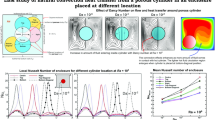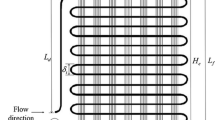Abstract
This article presents a porous media transport approach to model the performance of an air-cooled condenser. The finned tube bundles in the condenser are represented by a porous matrix, which is defined by its porosity, permeability, and the form drag coefficient. The porosity is equal to the tube bundle volumetric void fraction and the permeability is calculated by using the Karman–Cozney correlation. The drag coefficient is found to be a function of the porosity, with little sensitivity to the way this porosity is achieved, i.e., with different fin size or spacing. The functional form was established by analyzing a relatively wide range of tube bundle size and topologies. For each individual tube bundle configuration, the drag coefficient was selected by trial and error so as to make the pressure drop from the porous medium approach match the pressure drop calculated by the heat exchanger design software ASPEN B-JAC. The latter is a well-established commercial heat exchanger design program that calculates the pressure drop by using empirical formulae based on the tube bundle properties. A close correlation is found between the form drag coefficient and the porosity with the drag coefficient decreasing with increasing porosity. A second order polynomial is found to be adequate to represent this relationship. Heat transfer and second law (of thermodynamics) performance of the system has also been investigated. The volume-averaged thermal energy equation is able to accurately predict the hot spots. It has also been observed that the average dimensionless wall temperature is a parabolic function of the form drag coefficient. The results are found to be in good agreement with those available in the open literature.
Similar content being viewed by others
Abbreviations
- A :
-
Flow cross-sectional area, m2
- C F :
-
Form drag coefficient
- c p :
-
Specific heat at constant pressure (of fluid), J/Kg K
- d :
-
Diameter, m
- e p :
-
Normalized excess pressure drop because of fins
- e q :
-
Normalized heat transfer enhancement because of fins
- k :
-
Turbulent kinetic energy per unit mass, (m/s)2
- K :
-
Permeability, m2
- L :
-
Tube length, m
- \({\dot {m}}\) :
-
Mass flow rate, Kg/s
- N :
-
Number
- p :
-
Pressure, Pa
- P * :
-
Pressure gradient, Pa/m
- Q :
-
Total heat transfer rate, W
- q b :
-
Volumetric heat generation rate, W/m3
- Ns :
-
Entropy generation number
- Pr T :
-
Turbulent Prandtl number
- Re K :
-
Reynolds number with K 1/2 as the length scale, Re K = V K 1/2/υ
- S :
-
Tube pitch, m
- \({\dot {S}_{\rm gen}}\) :
-
Entropy generation rate, W/K
- \({S_\phi}\) :
-
Source term for \({\phi}\) equation
- t :
-
Fin thickness, m
- T :
-
Temperature, K
- u :
-
x-Velocity, m/s
- v :
-
y-Velocity, m/s
- V :
-
Face velocity, m/s
- x :
-
Horizontal coordinate, m
- y :
-
Vertical coordinate, m
- α :
-
Effective thermal diffusivity of the fluid/porous medium, m2/s
- ε :
-
Dissipation rate of turbulent kinetic energy, m2/s3
- \({\Gamma_\phi}\) :
-
Diffusion parameter for \({\phi}\) equation, m2/s
- θ :
-
Dimensionless temperature
- ρ :
-
Fluid density, Kg/m3
- υ :
-
Kinematic viscosity, m2/s
- \({\phi}\) :
-
Generic variable
- φ :
-
Porosity
- ave:
-
Average
- b:
-
Bundle
- eff:
-
Effective
- f:
-
Fin
- in:
-
Inlet
- m:
-
Mean
- out:
-
Outlet
- ref:
-
Of reference temperature
- t:
-
Tube
- T:
-
Turbulent
- w:
-
Wall
- x, y:
-
In x, y direction
References
Antohe B.V., Lage J.L.: A general two-equation macroscopic turbulence model for incompressible flow in porous media. Int. J. Heat Mass Transf. 40(13), 3013–3024 (1997)
Bejan A.: Entropy Generation Through Heat and Fluid Flow. Wiley, New York (1992)
Bejan A., Morega A.M.: Optimal arrays of pin fins and plate fins in laminar forced-convection. J. Heat Transf.-Trans. ASME 115(1), 75–81 (1993)
Bejan A., Dincer I., Lorenteh S., Miguel A.F., Reis A.H.: Porous and Complex Flow Structures in Modern Technologies. Springer, New York (2004)
Bilen K., Akyol U., Yapici S.: Thermal performance analysis of a tube finned surface. Int. J. Energy Res. 26(4), 321–333 (2002)
de Lemos M.J.S.: Turbulence in Porous Media: Modeling and Applications. Elsevier Science, Oxford (2006)
Do K.H., Min J.Y., Kim S.J.: Thermal optimization of an internally finned tube using analytical solutions based on a porous medium approach. J. Heat Transf.-Trans. ASME 129(10), 1408–1416 (2007)
Ejlali, A., Hooman, K.: A comparative study on dry cooling of different working fluids for geothermal applications. In: Gurgenci, H., Budd, A. (eds.) Australian Geothermal Energy Conference. Melbourne, Australia (2008)
Fisher T.S., Torrance K.E.: Free convection limits for pin-fin cooling. J. Heat Transf.-Trans. ASME 120(3), 633–640 (1998)
Hooman K.: Entropy generation for microscale forced convection: Effects of different thermal boundary conditions, velocity slip, temperature jump viscous dissipation, and duct geometry. Int. Commun. Heat Mass Transf. 34(8), 945–957 (2007)
Hooman K., Haji-Sheikh A.: Analysis of heat transfer and entropy generation for a thermally developing Brinkman–Brinkman forced convection problem in a rectangular duct with isoflux walls. Int. J. Heat Mass Transf. 50(21–22), 4180–4194 (2007)
Hooman K., Hooman F., Mohebpour S.R.: Entropy generation for forced convection in a porous channel with isoflux or isothermal walls. Int. J. Energy 5(1), 78–96 (2008)
Hooman, K., Gurgenci, H.: Air cooled porous matrix heat exchangers for geothermal applications. In: Gurgenci, H., Budd, A. (eds.) Australian Geothermal Energy Conference. Melbourne, Australia (2008)
Hooman K., Gurgenci H., Merrikh A.A.: Heat transfer and entropy generation optimization of forced convection in porous-saturated ducts of rectangular cross-section. Int. J. Heat Mass Transf. 50(11–12), 2051–2059 (2007)
Joseph D.D., Nield D.A., Papanicolaou G.: Non-linear equation governing flow in a saturated porous-medium. Water Resour. Res. 18(4), 1049–1052 (1982)
Kays W.M., London A.L.: Compact Heat Exchangers. 3rd edn. McGraw-Hill, Sydney (1984)
Kim S.J., Kim D.: Forced convection in microstructures for electronic equipment cooling. J. Heat Transf.-Trans. ASME 121(3), 639–645 (1999)
Kim, T., Lu, T.J.: Pressure drop through anisotropic porous medium like cylinder bundles in turbulent flow regime. J. Fluids Eng.-Trans. ASME 130(10), article # 104501 (2008)
Kim S.J., Yoo J.W., Jang S.P.: Thermal optimization of a circular-sectored finned tube using a porous medium approach. J. Heat Transf.-Trans. ASME 124(6), 1026–1033 (2002)
Lage J.L.: The fundamental theory of flow through permeable media from Darcy to turbulence. In: Ingham, D.B., Pop, I. (eds) Transport Phenomena in Porous Media, Pergamon, Oxford (1998)
Lage J.L., Antohe B.V.: Darcy’s experiments and the deviation to nonlinear flow regime. J. Fluids Eng.-Trans. ASME 122(3), 619–625 (2000)
Lage J.L., Antohe B.V., Nield D.A.: Two types of nonlinear pressure-drop versus flow-rate relation observed for saturated porous media. J. Fluids Eng.-Trans. ASME 119(3), 700–706 (1997)
Mahjoob S., Vafai K.: A synthesis of fluid and thermal transport models for metal foam heat exchangers. Int. J. Heat Mass Transf. 51, 3701–3711 (2008)
Merrikh A.A., Lage J.L., Mohamad A.A.: Natural convection in nonhomogeneous heat-generating media: Comparison of continuum and porous-continuum models. J. Porous Media 8(2), 149–163 (2005)
Miguel A.F.: Airflow through porous screens: from theory to practical considerations. Energy Buildings 28(1), 63–69 (1998)
Morega A.M., Bejan A., Lee S.W.: Free-stream cooling of a parallel plates. Int. J. Heat Mass Transf. 38(3), 519–531 (1995)
Nakayama A., Kuwahara F.: A macroscopic turbulence model for flow in a porous medium. J. Fluids Eng.-Trans. ASME 121(2), 427–433 (1999)
Nield D.A.: Effects of local thermal nonequilibrium in steady convective processes in a saturated porous medium: Forced convection in a channel. J. Porous Media 1(2), 181–186 (1998)
Nield D.A.: Alternative models of turbulence in a porous medium, and related matters. J. Fluids Eng.-Trans. ASME 123(4), 928–931 (2001)
Nield D.A.: Modelling fluid flow in saturated porous media and at interfaces. In: Ingham, D.B., Pop, I. (eds) Transport Phenomena in Porous Media II, Elsevier Science, Oxford (2002)
Nield D.A., Bejan A.: Convection in Porous Media. 3rd edn. Springer, New York (2006)
Patankar S.V., Spalding D.B.: A calculation procedure for the transient and steady-state behavior of shell-and-tube heat exchanger. In: Afgan, N., Schlünder, E.U. (eds) Heat Exchangers: Design and Theory Sourcebook, Scripta Book Company, Washington (1974)
Qu W.L., Mudawar I.: Analysis of three-dimensional heat transfer in micro-channel heat sinks. Int. J. Heat Mass Transf. 45(19), 3973–3985 (2002a)
Qu W.L., Mudawar I.: Experimental and numerical study of pressure drop and heat transfer in a single-phase micro-channel heat sink. Int. J. Heat Mass Transf. 45(12), 2549–2565 (2002b)
Sasaguchi K., Takeo H.: Effect of the orientation of a finned surface on the melting of frozen porous-media. Int. J. Heat Mass Transf. 37(1), 13–26 (1994)
Stanescu G., Fowler A.J., Bejan A.: The optimal spacing of cylinders in free-stream cross-flow forced convection. Int. J. Heat Mass Transf. 39(2), 311–317 (1996)
Vafai K., Tien C.L.: Boundary and inertia effects on flow and heat-transfer in porous-media. Int. J. Heat Mass Transf. 24(2), 195–203 (1981)
Vassallo, P., Symolon, P.: Friction factor measurements in an equally spaced triangular array of circular tubes. J. Fluids Eng.-Trans. ASME 130(4), article # 041105 (2008)
Whitaker S.: The Method of Volume Averaging. Kluwer Academic, Dordrecht (1999)
Author information
Authors and Affiliations
Corresponding author
Rights and permissions
About this article
Cite this article
Hooman, K., Gurgenci, H. Porous Medium Modeling of Air-Cooled Condensers. Transp Porous Med 84, 257–273 (2010). https://doi.org/10.1007/s11242-009-9497-8
Received:
Accepted:
Published:
Issue Date:
DOI: https://doi.org/10.1007/s11242-009-9497-8




